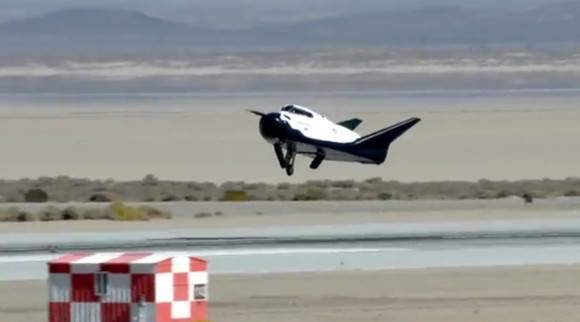Commercial space company Sierra Nevada Corporation and NASA announced plans today to launch an orbital test flight of the Dream Chaser vehicle in 2016, and that they plan to use processing facilities at Kennedy Space Center as well as land the vehicle at NASA’s Shuttle Landing Facility in Florida.
“Today we’re very proud to announce that we have now formally negotiated our orbital spaceflight,” said Mark Sirangelo, the head of Sierra Nevada Space Systems. “We have acquired an Atlas V rocket and established a launch date of November 1, 2016, so in a little over two years from now and we’re going to be taking our vehicle to space on the board one of the best rockets that has ever been designed, the Atlas V.”
The mission will be automated and unmanned, but if all goes well Sierra Nevada hopes to have a human flight by sometime in 2017.

The seven-passenger vehicle looks like a mini-space shuttle and is about 9 meters long (29.5 feet) with a wingspan of 7 meters (22.9 feet).
Sirangelo said they will be doing Dream Chaser pre- and post-flight processing at KSC along with Lockheed Martin at the Operations and Checkout (O&C) facility at KSC. The O&C is an historic facility which was originally built to process Gemini and Apollo era spacecraft. After significant upgrades by NASA and the State of Florida, it is currently being used by Lockheed Martin Space Systems to develop, assemble and test NASA’s Orion spacecraft.
The 2017 flights will be the first time an Atlas V will be used to send people to space since the Mercury program. The landing at the SLF will be the first landing of a space vehicle there since the final space shuttle mission, STS-135, landed there on July 21, 2011.
“That is way too long (between landings),” said Steve Lindsey, former NASA astronaut and now Sierra Nevada’s Dream Chaser program manager, “and we intend to do something about it and do it very soon… We want to continue the long tradition that was started on the Florida space coast so many years ago.”
During a question and answer period with media, questions were asked about which entity is paying for which portions of the launch and processing. But the officials were coy about not answering those questions directly.
Officials from NASA, Sierra Nevada, Lockheed Martin, United Launch Alliance and Space Florida took part in the announcement, which you can watch below.
“Today’s announcement confirms the faith the commercial industry has in Kennedy Space Center,” said Bob Cabana, the director of Kennedy Space Center.

The Dream Chaser had a test landing in October, 2013 after it was hoisted in the air by a helicopter. The automated landing went well except that one of the landing gears failed to deploy properly.
Sierra Nevada announced last week that they had completed their latest milestone for the NASA’s commercial crew program, the Commercial Crew Integrated Capability (CCiCap), Milestone 7, which is the Certification Plan Review for the entire Dream Chaser Space System. They delivered nearly 6,000 pages of technical documentation on the strategy, verification, and validation of Dream Chaser and its integration with the Atlas V launch vehicle and ground mission control systems.


“The automated landing went well except that one of the landing gears failed to deploy properly”
In aviation circles I believe this is known as a crash. Hopefully that little problem will be fixed.
The landing gear system on the test vehicle is not the same as the flight hardware, and wasn’t one of the systems being tested (well it was in a practical sense, but not as part of the test flight program). Apples to oranges to compare the two, but still embarassing as hell.
Oh look, an X-20 Dynasoar, oh, wait . .